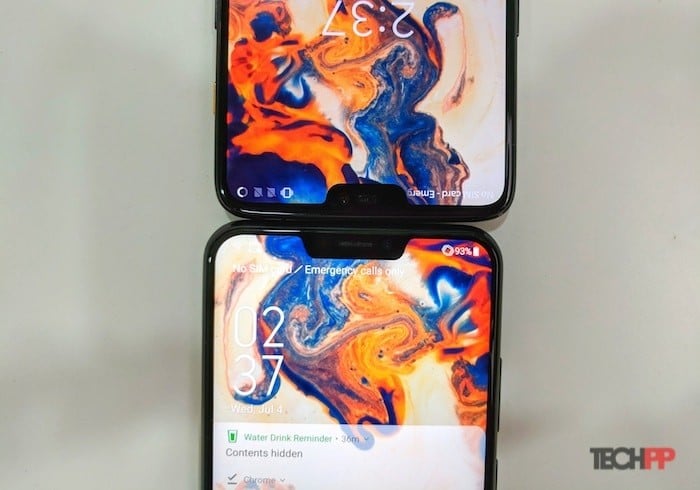Right out of the box, both the OnePlus 6 and Zenfone 5Z manage to tick two of the most essential boxes every modern smartphone aspires to — a notched screen and an all-glass exterior. However, there’s a vast difference in the implementations. For starters, the OnePlus 6 features a more elegant and ergonomic curved rear, while the Zenfone 5Z comes with Asus’ signature concentric circle pattern on a flat back which is not as comfortable to hold as the OnePlus 6. So while the Zenfone 5Z is the one which would stand out in a crowd, I personally prefer the OnePlus 6 whose curved chassis comes in handy when you’re operating that massive display. The OnePlus 6’s build has a number of other perks too. It’s water resistant so the phone can survive minor liquid splashes, there’s a hardware alert slider through which you can easily change the ringer profiles and the fingerprint sensor which is slightly faster. The stereo speakers on the 5Z are way better than the OnePlus 6’s bottom firing single speaker and Asus even bundles a pair of earphones in the box which are pretty good. Another upper hand the 5Z holds is the expandable storage but you will have to choose between two SIM cards or a MicroSD card for that. Call reception is flawless on in either case and yes, they’re compatible with Dual VoLTE as well. The screen on both of these phones, apart from the tiny piece of bezel at the top, is mostly edge to edge. Both also have the same 1080p resolution with weird aspect ratios. But the one on OnePlus 6 is slightly bigger at 6.28-inch as opposed to the 5Z’s 6.2-inch and has an OLED panel instead of an LCD. Because of that, the OnePlus 6’s display looks much more vibrant and enables features like ambient display. In general, though, there’s nothing wrong with either screen. They’re both sharp, clearly visible outdoors, and have perfect viewing angles. But if I had to pick a winner, it would be the OnePlus 6.
The software is a completely different story on these phones. While the OnePlus 6 comes with OnePlus’ own Android 8.1 based OxygenOS skin, the Zenfone 5Z features ZenUI which sadly is still running on Android 8.0. The former is also a lot cleaner with not much bloatware, whereas the latter has a shedload of unnecessary apps like Facebook’s entire suite which you cannot even uninstall. ZenUI also lacks navigation gestures which I feel should be now a mandatory feature on phones with tall screens. While both the software skins do perform smoothly, I think you will be happier with OxygenOS in a longer run. OnePlus is also already testing Android P for the OnePlus 6 and promises three years of security updates which is always a plus.
The area where the OnePlus 6 and the Zenfone 5Z are hard to differentiate is the specifications. Both of them have a Snapdragon 845 flagship processor, at least 6GB Of RAM, 64GB of internal storage, and a 3300mAh battery with quick charging. Performance, as you would expect, isn’t something you will have to worry about on either of these phones. Whether it’s regular multitasking or playing resource-intensive titles like PUBG, I didn’t encounter a single lag on both the phones. The battery life is roughly similar as well. Both of them can get you a minimum 5 hours of screen on time which if you’re a casual user, means more than a day. But thanks to OnePlus’ own Dash Charge technology, the OnePlus 6 can be charged relatively quicker. It takes just an hour to get topped up, while the 5Z needs about 90 minutes. The 5Z does have one pro which is that its fast charging technology is based on a universal standard, so it will be easier for you to buy or locate a new adapter.
Lastly, let’s talk about the cameras. The OnePlus 6 has two on the rear, a 16-megapixel f/1.7 RGB lens, and another 20-megapixel f/1.7 lens. On the front of it, you will find a 16-megapixel snapper which has an aperture of f/2.0. The Zenfone 5Z, on the other hand, has a 12-megapixel f/1.8 primary shooter and a secondary 8-megapixel f/2.0 wide angle lens. There’s an 8-megapixel sensor on the front as well.
In every scenario, whether it’s daylight or lowlight, I found the Zenfone 5Z to be a better camera among the two. Its pictures have a much more balanced dynamic range and accurate colors. The OnePlus 6 tends to overexpose and oversaturate shots which more often than not leads to an unnatural outcome. In dimly lit areas too, the Zenfone 5Z’s photos have lesser grain and better contrasts. The Portrait Mode functions more reliably on the OnePlus 6 with better edge detection, though.
The OnePlus 6 also wins the selfie round by having more details, courtesy of the higher resolution camera. For videos too, it’s a significantly better phone with stable and vibrant clips. The ones we recorded on the 5Z had a lot of stutters. That’s true for the slow-motion mode as well. The aspect where the 5Z comes out on the top is when you’re clicking landscapes and you need a wider lens (check the sample below). OnePlus 6 Camera Samples Asus Zenfone 5Z Camera Samples With better still photography and a much more affordable price, Asus’ Zenfone 5Z offers a better value among the two. However, if you’re someone who prefers a cleaner software and a more comfortable build, the OnePlus 6 won’t let you down either.












